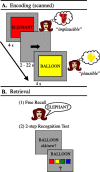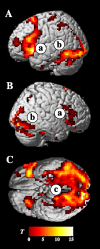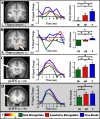Differential encoding mechanisms for subsequent associative recognition and free recall
- PMID: 16957073
- PMCID: PMC6674493
- DOI: 10.1523/JNEUROSCI.2877-06.2006
Differential encoding mechanisms for subsequent associative recognition and free recall
Erratum in
- J Neurosci. 2006 Sep 20;26(38):9836
Abstract
Recent neuroimaging studies have successfully identified encoding mechanisms that support different forms of subsequent episodic recognition memory. In our everyday lives, however, much of our episodic memory retrieval is accomplished by means of free recall, i.e., retrieval without an external recognition cue. In this study, we used functional magnetic resonance imaging to investigate the encoding mechanisms that support later free recall and their relationship to those that support different forms of later recognition memory. First, in agreement with previous work, we found that activation in the left inferior frontal gyrus and hippocampus correlated with later associative/relational recognition. In these regions, activation was further enhanced for items later freely recalled, pointing to shared underlying relational encoding mechanisms whose magnitude of activation differentiates later successful free recall from successful associative recognition. Critically, we also found evidence for free recall-specific encoding mechanisms that did not, in our paradigm, support later associative recognition compared with item recognition. These free recall-specific effects were observed in left mid/dorsolateral prefrontal (DLPFC) and bilateral posterior parietal cortices (PPC). We speculate that the higher-level working memory operations associated with DLPFC and attention to internal mnemonic representations perhaps mediated via PPC may serve to embed an item into a rich associative network during encoding that facilitates later access to the item. Finally, activation in the perirhinal cortex correlated with successful associative binding regardless of the form of later memory, i.e., recognition or free recall, providing novel evidence for the role of the perirhinal cortex in episodic intra-item encoding.
Figures





References
-
- Anderson JR, Bower GH. Recognition and retrieval processes in free recall. Psychol Rev. 1972;79:97–123.
-
- Awh E, Jonides J, Smith EE, Schumacher EH, Koeppe RA, Katz S. Dissociation of storage and rehearsal in verbal working memory: evidence from positron emission tomography. Psychol Sci. 1996;7:25–31.
-
- Badre D, Poldrack RA, Pare-Blagoev EJ, Insler RZ, Wagner AD. Dissociable controlled retrieval and generalized selection mechanisms in ventrolateral prefrontal cortex. Neuron. 2005;47:907–918. - PubMed
-
- Bahrick HP. Two-phase model for prompted recall. Psychol Rev. 1970;77:215–222.
Publication types
MeSH terms
LinkOut - more resources
Full Text Sources
